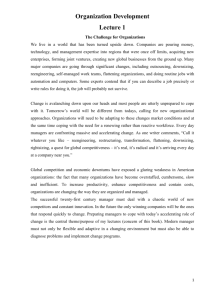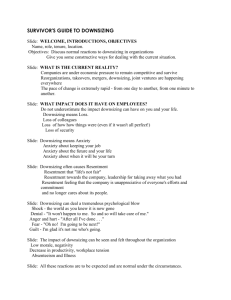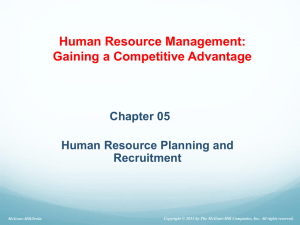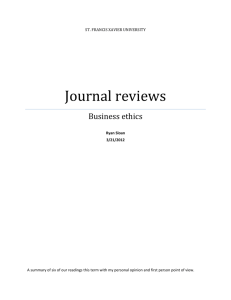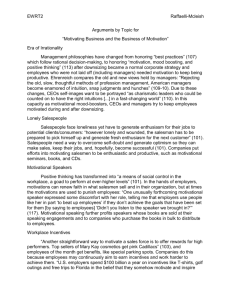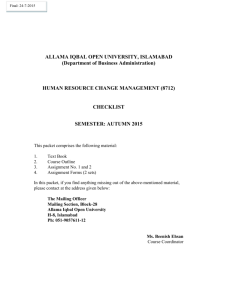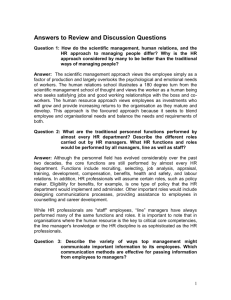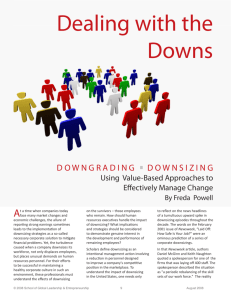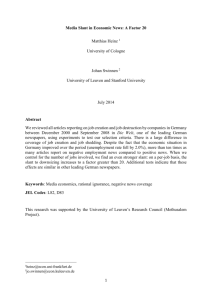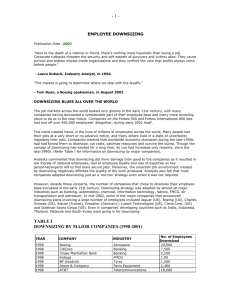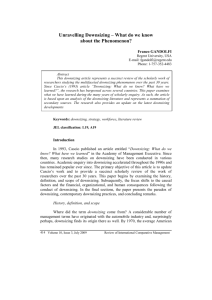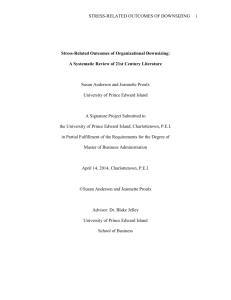Recommended Reading Downsizing Alternatives and Results.indd
advertisement
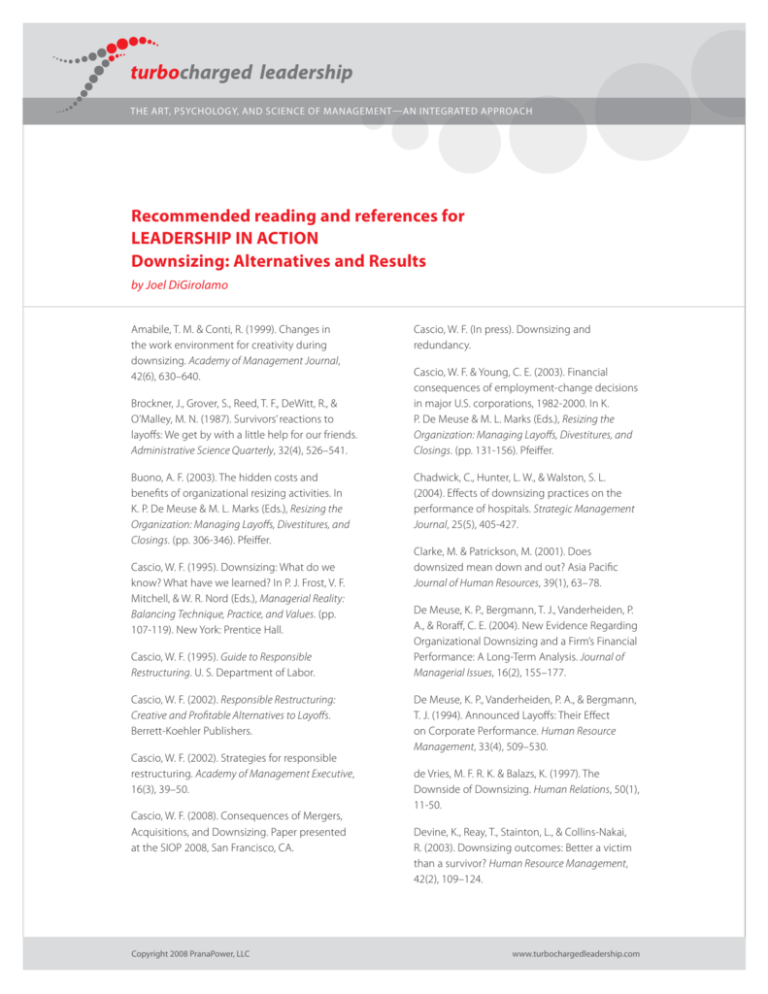
THE ART, PSYCHOLOGY, AND SCIENCE OF MANAGEMENT—AN INTEGRATED APPROACH Recommended reading and references for LEADERSHIP IN ACTION Downsizing: Alternatives and Results by Joel DiGirolamo Amabile, T. M. & Conti, R. (1999). Changes in the work environment for creativity during downsizing. Academy of Management Journal, 42(6), 630–640. Brockner, J., Grover, S., Reed, T. F., DeWitt, R., & O’Malley, M. N. (1987). Survivors’ reactions to layoffs: We get by with a little help for our friends. Administrative Science Quarterly, 32(4), 526–541. Buono, A. F. (2003). The hidden costs and benefits of organizational resizing activities. In K. P. De Meuse & M. L. Marks (Eds.), Resizing the Organization: Managing Layoffs, Divestitures, and Closings. (pp. 306-346). Pfeiffer. Cascio, W. F. (1995). Downsizing: What do we know? What have we learned? In P. J. Frost, V. F. Mitchell, & W. R. Nord (Eds.), Managerial Reality: Balancing Technique, Practice, and Values. (pp. 107-119). New York: Prentice Hall. Cascio, W. F. (1995). Guide to Responsible Restructuring. U. S. Department of Labor. Cascio, W. F. (2002). Responsible Restructuring: Creative and Profitable Alternatives to Layoffs. Berrett-Koehler Publishers. Cascio, W. F. (2002). Strategies for responsible restructuring. Academy of Management Executive, 16(3), 39–50. Cascio, W. F. (2008). Consequences of Mergers, Acquisitions, and Downsizing. Paper presented at the SIOP 2008, San Francisco, CA. Copyright 2008 PranaPower, LLC Cascio, W. F. (In press). Downsizing and redundancy. Cascio, W. F. & Young, C. E. (2003). Financial consequences of employment-change decisions in major U.S. corporations, 1982-2000. In K. P. De Meuse & M. L. Marks (Eds.), Resizing the Organization: Managing Layoffs, Divestitures, and Closings. (pp. 131-156). Pfeiffer. Chadwick, C., Hunter, L. W., & Walston, S. L. (2004). Effects of downsizing practices on the performance of hospitals. Strategic Management Journal, 25(5), 405-427. Clarke, M. & Patrickson, M. (2001). Does downsized mean down and out? Asia Pacific Journal of Human Resources, 39(1), 63–78. De Meuse, K. P., Bergmann, T. J., Vanderheiden, P. A., & Roraff, C. E. (2004). New Evidence Regarding Organizational Downsizing and a Firm’s Financial Performance: A Long-Term Analysis. Journal of Managerial Issues, 16(2), 155–177. De Meuse, K. P., Vanderheiden, P. A., & Bergmann, T. J. (1994). Announced Layoffs: Their Effect on Corporate Performance. Human Resource Management, 33(4), 509–530. de Vries, M. F. R. K. & Balazs, K. (1997). The Downside of Downsizing. Human Relations, 50(1), 11-50. Devine, K., Reay, T., Stainton, L., & Collins-Nakai, R. (2003). Downsizing outcomes: Better a victim than a survivor? Human Resource Management, 42(2), 109–124. www.turbochargedleadership.com THE ART, PSYCHOLOGY, AND SCIENCE OF MANAGEMENT—AN INTEGRATED APPROACH Dolan, S., Belout, A., & Balkin, D. B. (2000). Downsizing without downgrading: Learning how firms manage their survivors. International Journal of Manpower, 21(1/2), 34-46. Farrell, M. & Mavondo, F. T. (2004). The effect of downsizing strategy and reorientation strategy on a learning orientation. Personnel Review, 33(4), 383–402. Flanagan, D. J. & O’Shaughnessy, K. C. (2005). The Effect of Layoffs on Firm Reputation. Journal of Management, 31(3), 445-463. Grunberg, L., Moore, S., Greenberg, E. S., & Sikora, P. (2008). The Changing Workplace and Its Effects: A Longitudinal Examination of Employee Responses at a Large Company. Journal of Applied Behavioral Science, 44(2), 215-236. Hansen, F. (2008). Staffing, down to a science. Workforce Management, 1, 15-19. Hardy, G. E., Woods, D., & Wall, T. D. (2003). The impact of psychological distress on absence from work. Journal of Applied Psychology, 88(2), 306–314. Judge, T. A. & Bono, J. E. (2001). Relationship of Core Self-Evaluations Traits-Self-Esteem, Generalized Self-Efficacy, Locus of Control, and Emotional Stability-With Job Satisfaction and Job Performance: A Meta-Analysis. Journal of Applied Psychology, 86(1), 80-92. Kernan, M. C. & Hanges, P. J. (2002). Survivor reactions to reorganization: Antecedents and consequences of procedural, within-group, and informational justice. Journal of Applied Psychology, 87, 916-928. Copyright 2008 PranaPower, LLC Kivimäki, M., Vahtera, J., Elovainio, M., Pentti, J., & Virtanen, M. (2003). Human Costs of Organizational Downsizing: Comparing Health Trends Between Leavers and Stayers. American Journal of Community Psychology, 32(1), 57–67. Kivimäki, M., Vahtera, J., Pentti, J., & Ferrie, J. E. (2000). Factors underlying the effect of organisational downsizing on health of employees: Longitudinal cohort study. British Medical Journal, 320(7240), 971-975. Kivimäki, M., Vahtera, J., Pentti, J., Thomson, L., Griffiths, A., & Cox, T. (2001). Downsizing, changes in work, and self-rated health of employees: A 7-year 3-wave panel study. Anxiety, Stress & Coping, 14(1), 59–73. Krishnan, H. A., Hitt, M. A., & Park, D. (2007). Acquisition Premiums, Subsequent Workforce Reductions and Post-Acquisition Performance. Journal of Management Studies, 44(5). Laabs, J. (1999). Has Downsizing Missed Its Mark? Workforce, 78(4), 31-38. Lester, S. W., Kickul, J. R., Bergmann, T. J., & De Meuse, K. P. (2003). The effects of organizational resizing on the nature of the psychological contract and employee perceptions on contract fulfillment. In K. P. De Meuse & M. L. Marks (Eds.), Resizing the Organization: Managing Layoffs, Divestitures, and Closings. (pp. 78-107). Pfeiffer. Mikula, G. (Ed.). (1980). Beyond fairness: A theory of allocation preferences. New York: Springer-Verlag. Love, E. G. & Nohria, N. (2005). Reducing slack: The performance consequences of downsizing by large industrial firms, 1977-93. Strategic Management Journal, 26(12), 1087-1108. www.turbochargedleadership.com THE ART, PSYCHOLOGY, AND SCIENCE OF MANAGEMENT—AN INTEGRATED APPROACH Luss, R. & Nyce, S. A. (2002). How to Cut Costs Without Cutting Off Future Growth: Lessons From the Restructurings of the Early 1990s. Watson Wyatt Worldwide. Luthans, B. C. & Sommer, S. M. (1999). The Impact of Downsizing on Workplace Attitudes: Differing Reactions of Managers and Staff in a Health Care Organization. Group & Organization Management, 24(1), 46-70. Mentzer, M. S. (1996). Corporate downsizing and profitability in Canada. Canadian Journal of Administrative Sciences, 13(3), 237-250. Morris, J. R., Cascio, W. E., & Young, C. E. (1999). Downsizing after all these years: Questions and answers about who did it, how many did it, and who benefited from it. Organizational Dynamics, 27(3), 78–87. Nixon, R. D., Hitt, M. A., Lee, H. U., & Jeong, E. (2004). Market reactions to announcements of corporate downsizing actions and implementation strategies. Strategic Management Journal, 25(11), 1121-1129. Nohria, N. & Gulati, R. (1996). Is slack good or bad for innovation. Academy of Management Journal, 39(5), 1245–1264. Paulsen, N., Callan, V. J., Grice, T. A., Rooney, D., Gallois, C., Jones, E. et al. (2005). Job uncertainty and personal control during downsizing: A comparison of survivors and victims. Human Relations, 58(4), 463-496. Princeton Survey Research Associate International (2008). Security: What Americans want from a job. Copyright 2008 PranaPower, LLC Probst, T. M., Stewart, S. M., Gruys, M. L., & Tierney, B. W. (2007). Productivity, counterproductivity and creativity: The ups and downs of job insecurity. Journal of Occupational and Organizational Psychology, 80(3), 479-497. Reisel, W. D., Chia, S., Maloles, III, C. M., & Slocum, J. W., Jr. (2007). The Effects of Job Insecurity on Satisfaction and Perceived Organizational Performance. Journal of Leadership & Organizational Studies, 14(2), 106-116. Tan, J. & Peng, M. W. (2003). Organizational slack and firm performance during economic transitions: Two studies from an emerging economy. Strategic Management Journal, 24(13), 1249-1263. Thibaut, J. W. & Walker, L. (1975). Procedural justice: A psychological analysis. Lawrence Erlbaum Associates. Travaglione, A. & Cross, B. (2006). Diminishing the social network in organizations: Does there need to be such a phenomenon as ‘survivor syndrome’after downsizing? Strategic Change, 15(1), 1-13. Vahtera, J., Kivimäki, M., & Pentti, J. (1997). Effect of organisational downsizing on health of employees. The Lancet, 350(9085), 1124-1128. Vahtera, J., Kivimäki, M., Pentti, J., Linna, A., Virtanen, M., Virtanen, P. et al. (2004). Organisational downsizing, sickness absence, and mortality: 10-town prospective cohort study. British Medical Journal, 328(7439), 555-559. Wayhan, V. B. & Werner, S. (2000). The Impact of Workforce Reductions on Financial Performance: A Longitudinal Perspective. Journal of Management, 26(2), 341-363. www.turbochargedleadership.com THE ART, PSYCHOLOGY, AND SCIENCE OF MANAGEMENT—AN INTEGRATED APPROACH Wells, S. J. (2008). Managing a downturn. HR Magazine, 48-53. Wright, B. & Barling, J. (1998). `The executioners’ song’: Listening to downsizers reflect on their experiences. Canadian Journal of Administrative Sciences, 15(4), 339-354. Wright, T. A. & Bonett, D. G. (2007). Job Satisfaction and Psychological Well-Being as Nonadditive Predictors of Workplace Turnover. Journal of Management, 33(2), 141-160. Zatzick, C. D. & Iverson, R. D. (2006). Highinvolvement management and workforce reduction: competitive advantage or disadvantage? Academy of Management Journal, 49(5), 999–1015. Copyright 2008 PranaPower, LLC www.turbochargedleadership.com

